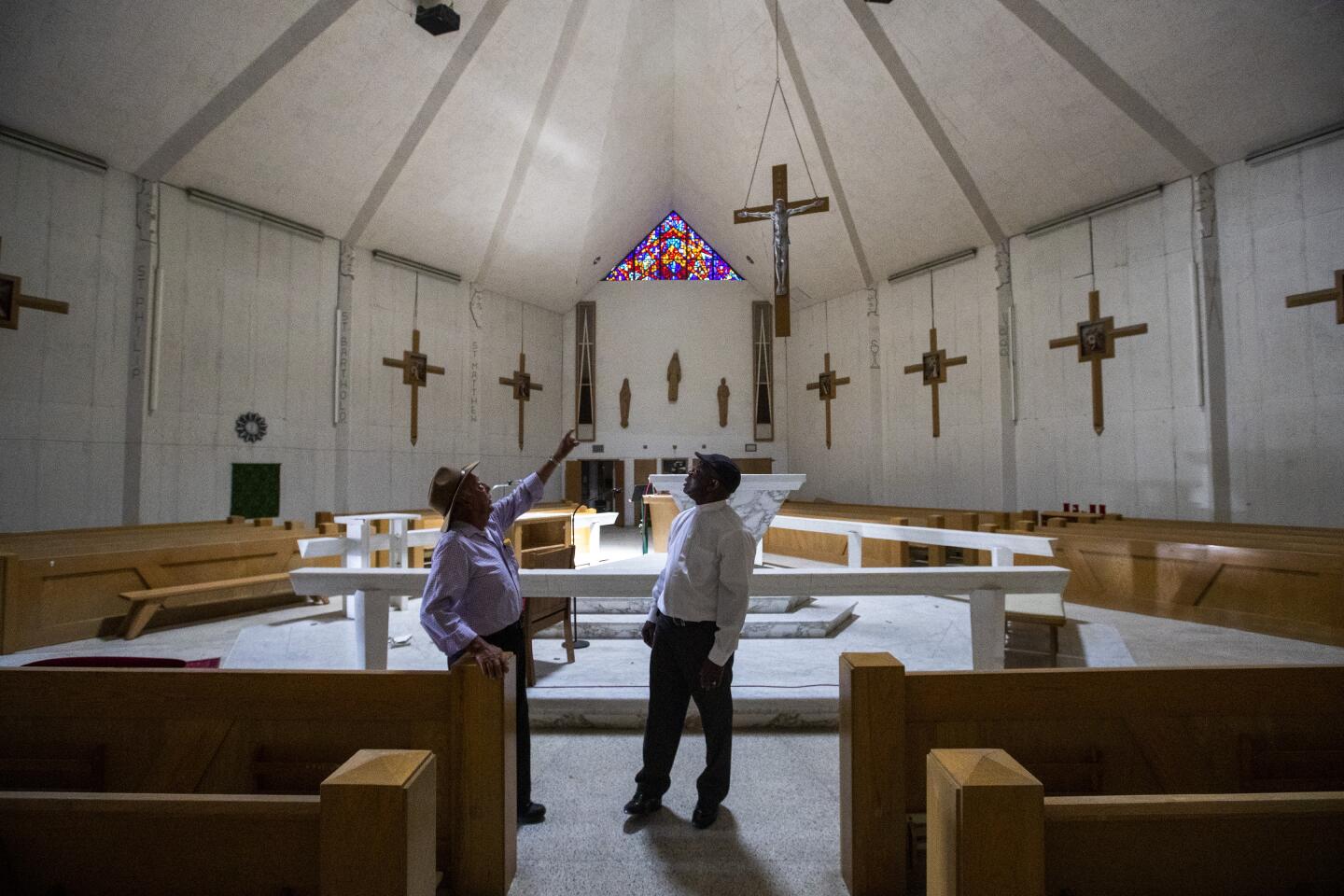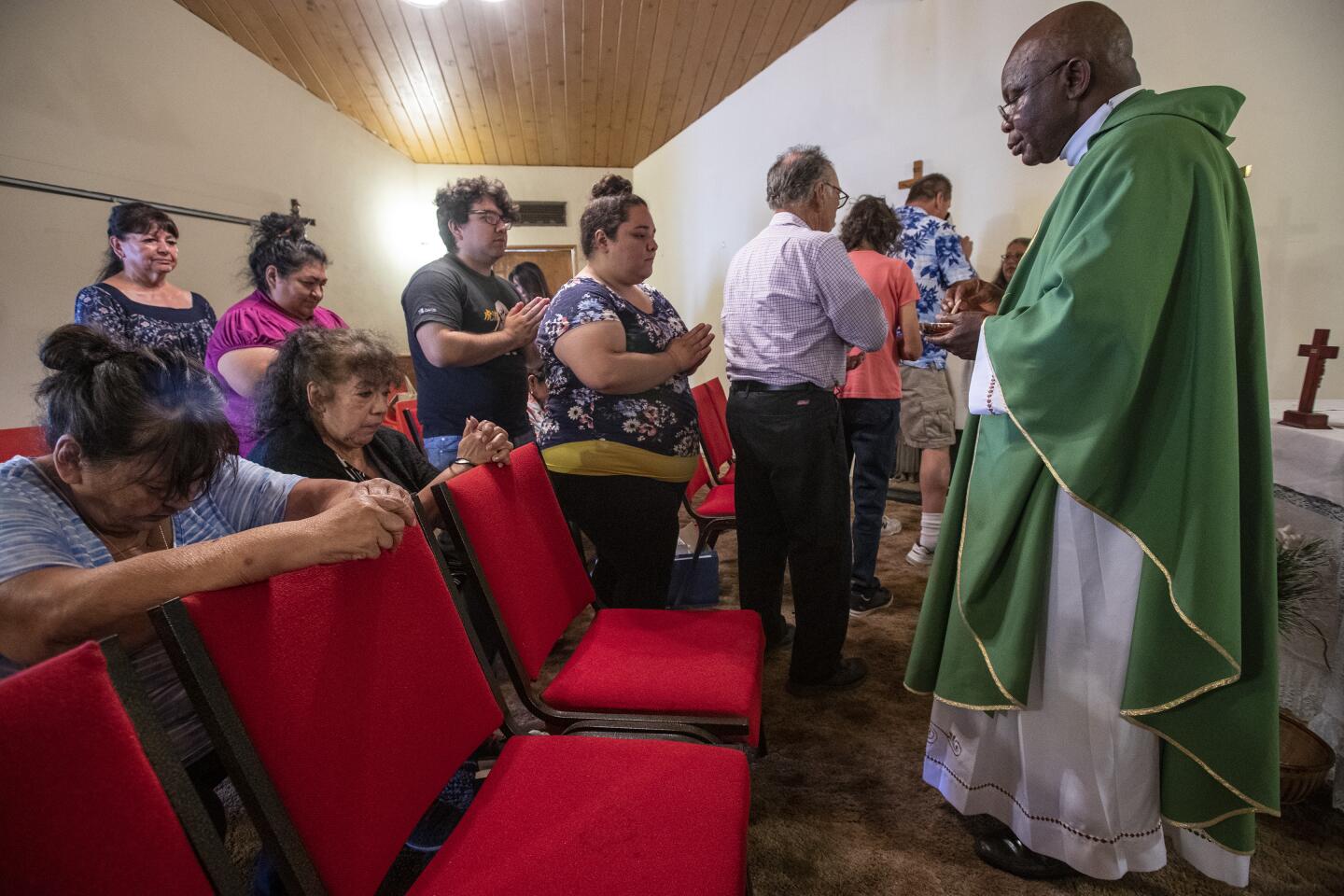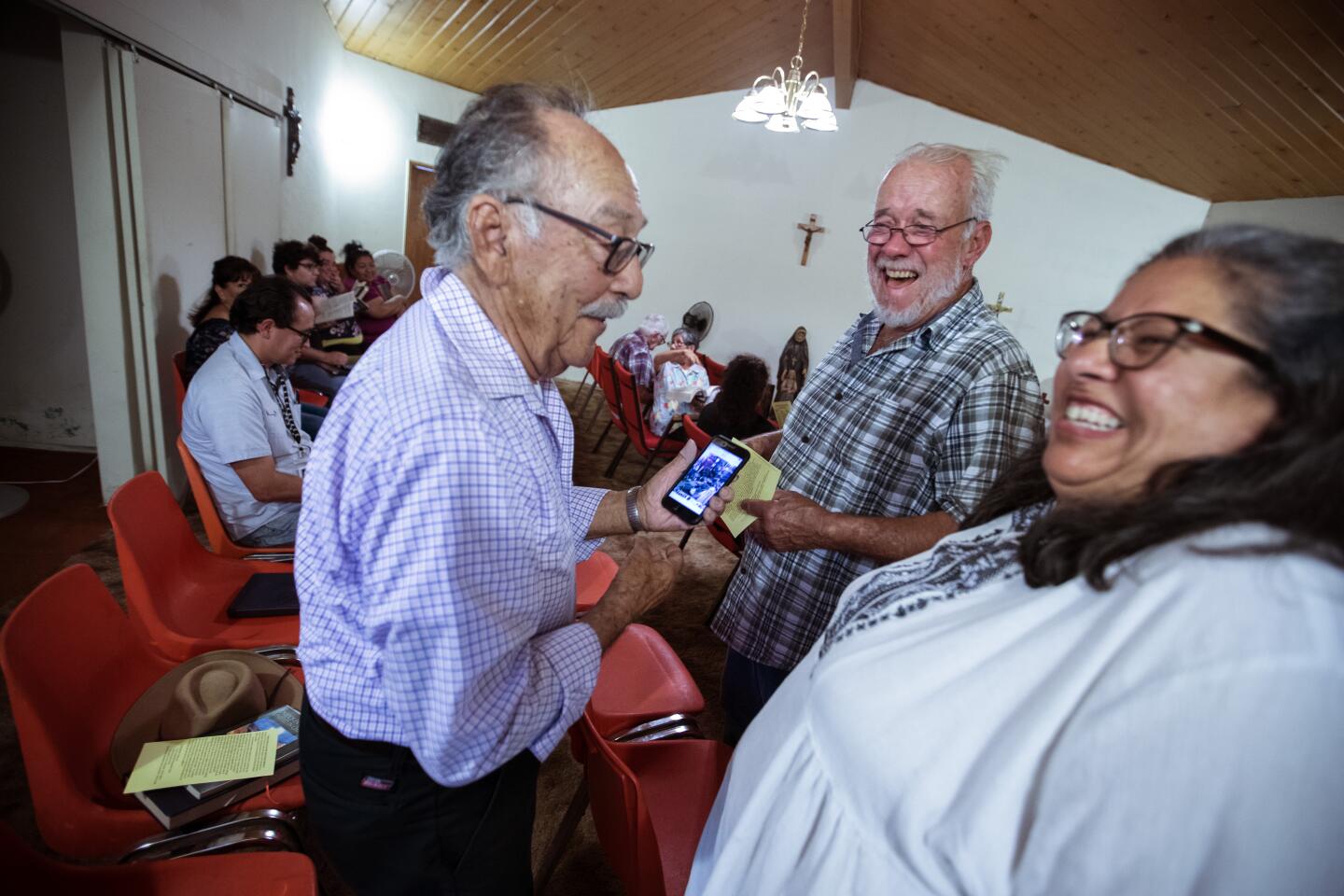Trona Catholics kept the faith as their town declined. Then, two earthquakes shook their ‘gem in the desert’

- Share via
TRONA, Calif. — The parishioners at St. Madeleine Sophie Barat Catholic Church — all 18 of them — didn’t need any more setbacks as they waited for Sunday Mass to start.
Decades of attrition had reduced a flock that once regularly packed the pews to their 300-person limit to just a couple dozen faithful, most of them middle-aged or elderly. Services had shrunk from twice-daily morning Masses to weekly to twice a month. Two years ago, the Diocese of San Bernardino relegated St. Madeleine from a parish to a mission, meaning it would no longer get a full-time priest. Instead, it would rely on clergy making the trip from St. Joseph’s in Barstow, 100 miles away.
On this day, July 28, the faithful gathered for St. Madeleine’s first service since a pair of powerful earthquakes and smaller aftershocks over the Fourth of July weekend wrecked the mining town and left St. Madeleine’s community hall and famous church red-tagged. The priest was half an hour late.
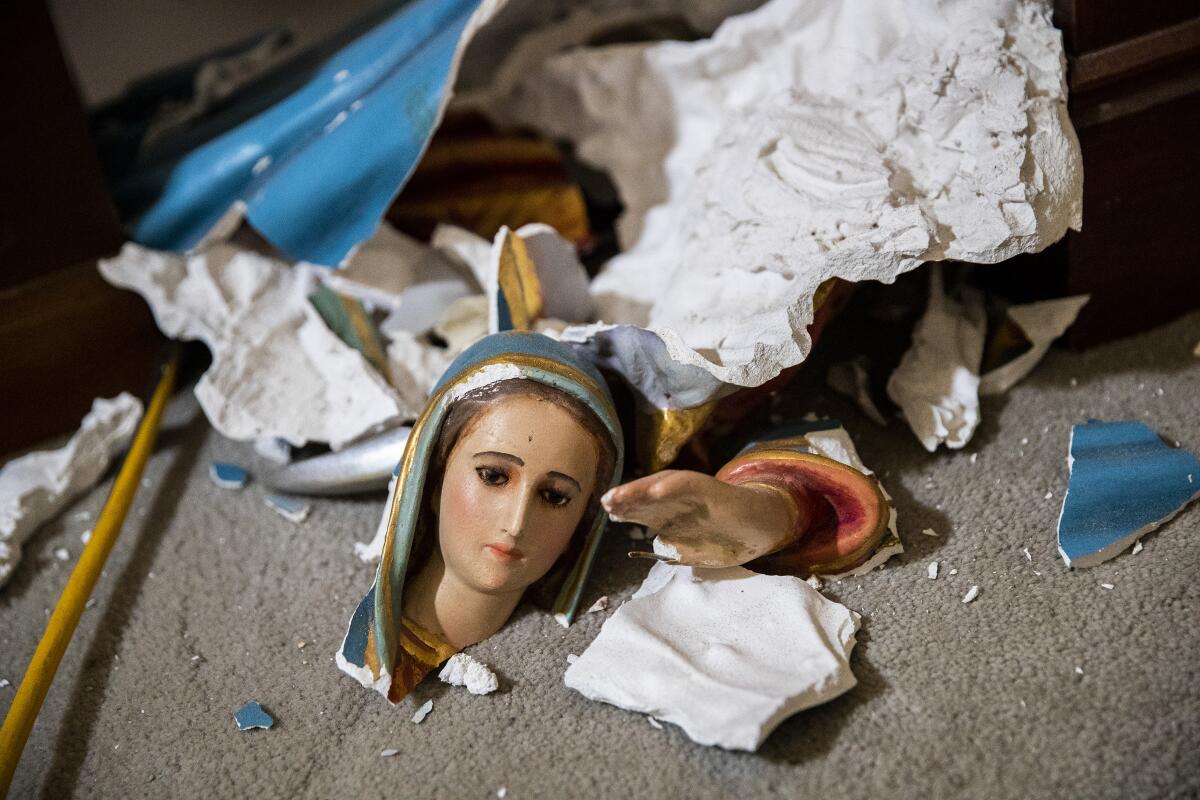
Families and single people, baby boomers and one teenager waited patiently in their temporary house of God, a potluck room in the former rectory decorated simply with crucifixes and large wooden statues of the Virgin Mary and St. Madeleine herself that parishioners pulled from the damaged church. (Jesus, while saved, was too cracked to make an appearance.)
Finally, Father Remigius O. Owuamanam showed up.
“Does anyone need to give confession?” he asked apologetically. Only one person volunteered.
But the padre rebounded from his tardiness. Preaching from a makeshift altar a stone’s toss away from the garage, Owuamanam turned his homily into an impromptu therapy session. The Nigerian native set everyone at ease by admitting he hadn’t previously ever felt a temblor, describing them as “like rising from the dead.” He then encouraged attendees to talk about the terror they’ve lived in ever since, especially the aftershocks so common that 80-year-old Charles Schmuck, who sat near the front, described them as “a kind of alarm.”
“Let us not be hopeless in a hopeless situation,” Owuamanam said before reminding everyone about the 75th Psalm, the one that reads, “Though the earth and all its inhabitants quake, I make steady its pillars.”

“God knew this Mass would happen today,” the priest continued, as the room nodded in approval. Multiple pedestal fans rattled across the room, trying to keep everyone cool in the 113-degree heat. “When you called, the Lord heard your prayer.”
St. Madeleine worshipers appreciated hearing the Good News. But they also want to get some good news about their earthly future, too, which didn’t look too promising even before getting shut out of their church.
“It’s sad,” said 89-year-old Andrew Ledesma, a retired auto mechanic and Air Force veteran who has attended St. Madeleine his entire life. “The only time we’re filled is for a wedding or a funeral. And there’s more of the latter these days.”
In many ways, the story of St. Madeleine mirrors that of its hometown.
Catholics in the Searles Valley first celebrated Mass in 1924, just a couple of years before Ledesma’s parents immigrated to Trona from Yahualica, Jalisco. Enough families, mostly white and Latino, moved in so that St. Madeleine — named after an 19th century French nun — became a full parish in 1937; in 1958, the growing congregation erected a new building on land donated by the American Potash and Chemical Corp., the area’s main employer.
Trona’s population was 6,000 and growing. Newspapers called the area the “valley of churches” for all of its Christian denominations. So St. Madeleine’s longtime priest, Father Rene Peter, didn’t want to construct just any traditional church, said Ledesma. “He wanted to create a gem in the desert.”
Peter designed, on his own, a windowless, whitewashed church that rose near the shores of Searles Lake, the dry expanse from where Trona mined borax, ash and other minerals. St. Madeleine took the shape of a triangle to reflect the Trinity, with 12 columns representing the apostles.
Stark, tall, and imposing, it was hailed by architecture critics as a modernist masterpiece. A Los Angeles design firm, in a pamphlet published shortly after St. Madeleine’s opening, enthused that the structure “transcended the limits of the isolated local to excite the interest of those engaged in the field of modern religious architecture.” The San Bernardino Diocese, on its website, says that the “many visitors who have toured the church have voiced one agreement — that the church, set against the infinite vastness of the surrounding desert, projects a sense of eternity.”
Tourists and pilgrims from around the world have visited ever since, but left Trona almost as fast. Patricia Scyrkles, who moved here from New Mexico in 1985, always remembers the benediction a visiting priest once gave St. Madeleine.
“He said, ‘All of you are going straight to heaven,’” the 65-year-old recounted, “‘because you’ve lived in hell.’”
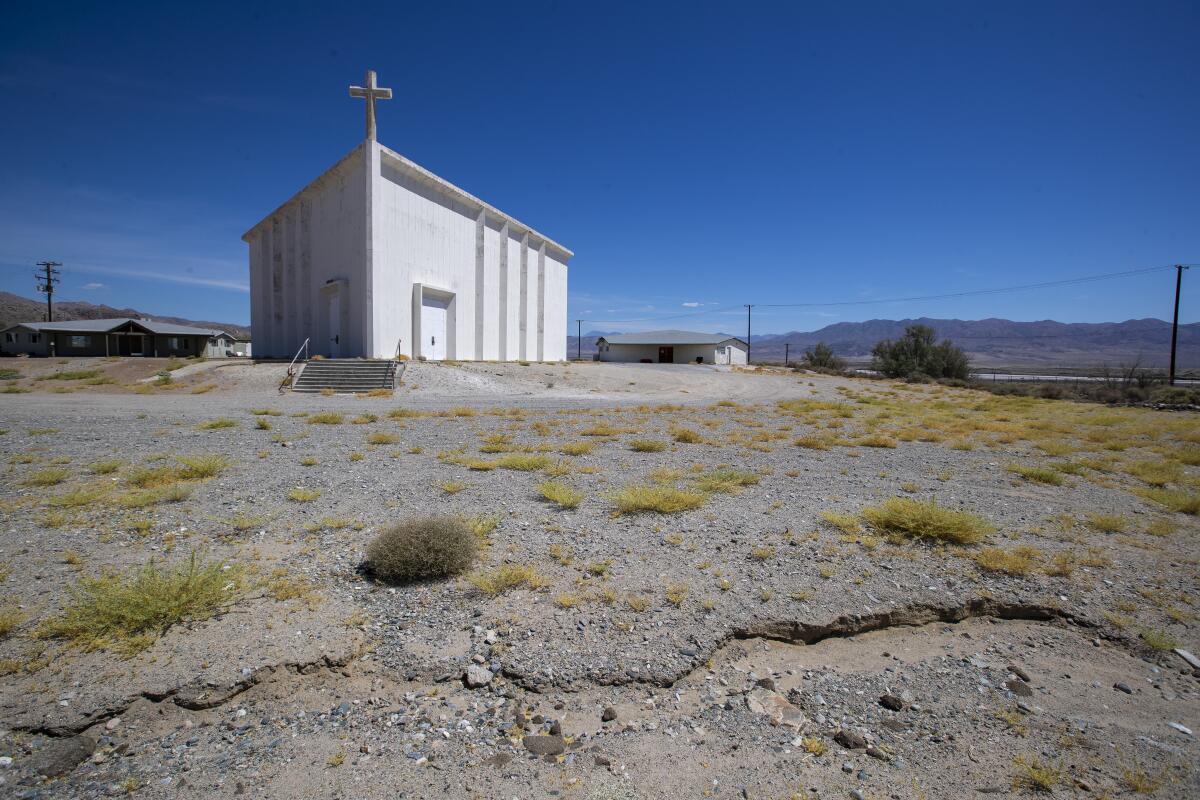
The priest referred to Trona’s inhospitable climate, but perhaps also to its declining fortunes. The town hemorrhaged residents as the mining plant laid off workers, and nearby Ridgecrest grew larger as the nearby Naval Air Weapons Station China Lake expanded. The Mormon, Methodist, and Episcopal churches shut down.
“There’s a few of us that are stubborn,” jokes Ledesma, whose three younger sisters also regularly attend Mass. “It’ll continue. We’ll be here.”
Scyrkles, who’s the only layperson with keys to St. Madeleine, lays out the chalice, sacramental bread and holy water before Mass; her sister, 61-year-old Cris Vigil, gives parishioners a taste of wine after receiving Communion. Ledesma does maintenance.
The trio are some of the last people to have entered the damaged St. Madeleine. It remains standing, but cracks weakened the ceiling, walls, and floor. Rebar is visible on the edge of the roof; concrete chunks of it litter the outside. More fissures seem to sprout every day.
San Bernardino County building authorities gave Scyrkles and others 15 minutes to grab what they could on July 10, when they red-tagged St. Madeleine. The group managed to take vestments, the tabernacle and the Holy Host. They wanted to also get out large statues that depicted the Stations of the Cross, but found them too heavy.
“You never know how much you need for Mass until you’ve got a time clock behind you,” she said with a tired smile.
John Andrews, director of communications for the San Bernardino Diocese, said inspectors need to check St. Madeleine more thoroughly before deciding on its buildings. He added that Father Peter’s design, as “unique” as it was, put too much stress on the joints that connect the roof to the wall. Any significant blow to them, and St. Madeleine becomes unsalvageable.
“I know the people who belong to that community love it,” he said. “They’re besides themselves at the thought the church may not survive.”
In the meanwhile, Catholics across San Bernardino County raised tens of thousands of dollars during a special weekend collection at the behest of Bishop Gerald Barnes, who penned a letter that asked them to pray for St. Madeleine but also “refocus our efforts in preparedness.”

For now, St. Madeleine regulars plan to continue as if everything were normal. That is to say, tough.
Patricia Ortega, 44, frets that she needs to drive her daughter to Ridgecrest, half an hour away, for First Communion classes.
Christal and Bryant Robles, siblings in their 20s, feel an extra weight of expectations as some of St. Madeleine’s youngest members.
“The future is not looking good, but we’re not going to stop,” said Christal Robles, a math teacher at Trona High School. She said St. Madeleine leans on the siblings for church readings and other physical activities.
“We’re more than happy to help in any way,” Bryant Robles said, noting that older parishioners especially liked it when their mother brings pozole and mole for potlucks because “everyone loves Mexican food.”
Driving in from Barstow to see how they could help, Heidi and Gilbert Rodriguez felt “humbled” by the St. Madeleine community.
“At our big church, we have air conditioning, yet barely any people go,” Heidi Rodriguez said after Mass, as everyone rushed to the A/C of their cars. “Here, look at everyone. They see the blessings that they have. You can donate all you want, but until you see faith like this, you can’t appreciate it.”
More to Read
Sign up for Essential California
The most important California stories and recommendations in your inbox every morning.
You may occasionally receive promotional content from the Los Angeles Times.
